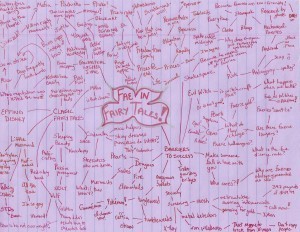Why Mind-Mapping Can Save the World!
Okay, maybe it won’t be able to save THE world but it can save your world! Let’s face it, all writers get stuck. All of ‘em. Sometimes you get stuck in the beginning when you are just formulating an idea. Other times, you need to revise and help get yourself unstuck from a sticky situation.
If you know you’re stuck and you’re staring at your document trying to think of answers, try a mind-map!
Mind-maps appeal to both visual and linear thinkers. Visual learners don’t have to fit everything on staggered lines and linear thinkers can outline the ideas after into a standard format. By branching outward, you can uncover ideas that are more obscure in relation to your original idea. This will help you explore unconventional associations to the central idea. You might even pull a few free-associative ideas that don’t directly connect back to your central idea–and that’s okay! Just go with it.
Will your map be pretty and visually pleasing when you’re finished? If it is, you’re freakishly talented. Mine are messy and flawed, complicated and scribbled. What matters is the ideas are there and you find diamonds in the rough of your mind.
HOW TO MINDMAP
In the center of your mind-map, write down the central idea or word that most resounds with the issue where you are stuck.
Next, branch off this idea with words, ideas, or terms that generate from that central idea.
Next, treat each branch as its own center and branch off that word or idea with new terms and ideas. There might only be tangentially related to the central idea or they might still seem directly related. Don’t judge the ideas–just keep branching out!
The further you get away from the center, the more estranged the ideas will become. Maybe you’ll get so far away that the next idea is the complete antithesis to the central idea you started with. And that’s okay! Just keep building.
TIPS AND TRICKS
Set a timer. A timer will force you to focus on the mind-map and keep drawing. Best timeframes to work in? Probably around 5-10 minutes. You might find that 7 minutes is that sweet spot to get the right amount of ideas. You might find that 10 minutes means you are writing as tiny as possible to make sure you stay on the page. Just focus on the mapping.
Turn the paper sideways. Seriously. Seeing pages differently can elicit different ideas. Literally, write against the grain of the paper.
Change it up. If you find you normally star branching on the left, try branching initially from the top, bottom, or right. Changing the direction, even for the initial point, can keep your brain stimulated every time you map.
Use colour. Use coloured pens different from your writing and editing pens. If you plan to do a different colour every level of depth you get away from the central idea, perhaps write in black to the begin with and then highlight the terms later. Switching pens and counting how many layers you are out while mind-mapping can slow your progress and keep you engrossed in other things than needed to diverge your thoughts.
Branch off images or art. If you are inspired by a piece of art, print of a miniature of that art and place it in the center of the map. Branch off the image and see where ideas take you. Look at colours, shading, faces, angles, textures etc! Even if a part seems tiny, branch off of it. It will add nuances to your ideas.
Type it up. After finishing, if you are a linear thinker, feel free to type up your mind map for reference later. Tab in your levels as you get further away from the central idea. You can also do this if you aren’t sure you can read your scrawl and generally messiness later.
Embrace incubation. You might finish your mind-map and have the perfect answer right away. If you do, fantastic! But you might not. You might be holding your pen over your mess and think, “Wow, Kate. Really? This was horrible.” All is not lost! After reviewing your mind-map, take some time off to let your subconscious mull it over. Believe it or not, your brain will think things over when you’re not. You know how you find things when you’re not looking for them, after you spent the entire morning FREAKING OUT? Exactly. Let your subconscious work. It might be a few hours, it might be a few days. – Round two! Come back and do another mind-map. Compare it to your first one. See what’s different and what’s recurring. Take either a recurring topic or a new one and mind-map with that. See where you go.
Let go. There is no wrong way to do this. Relax, and have fun.
WRITERLY APPLICATIONS
Generate anthology ideas. Often, those writing for an anthology will take the first idea that comes into their head. That idea might be fantastic…but you might be worried is over-done or the editor will receive a handful of ideas on a similar premise. Take the central idea and branch out from it. Even if the original idea is more obscure, you will find a more unique idea if you take a step back. Often, these step-back stories have more marketability if you don’t make it into the anthology but still want to sell it.
Build Worlds. Write the name of your world and some keywords. Economics? Social Structure? Food? Arts? Build off from there and see what ideas you get to make your world as fully flashed out as possible.
Murder writers block. Get more divergent ideas and see where they take you!
EXAMPLES
That’s right. I challenged the 3 of us to mindmap on the same topic. The results are forthcoming….except here is my jewel!
We all mapped on the same topic: for an anthology involving fae in fairy tales.

Click to see the full version!
Anxiety Ink
- Kate Larking's profile
- 53 followers



